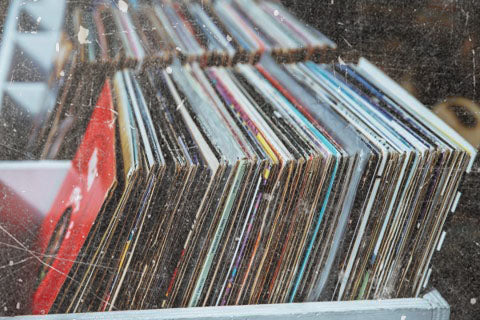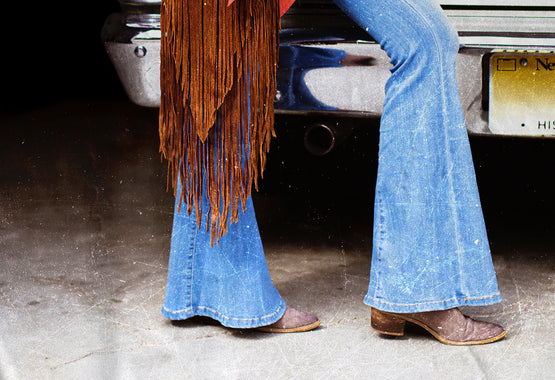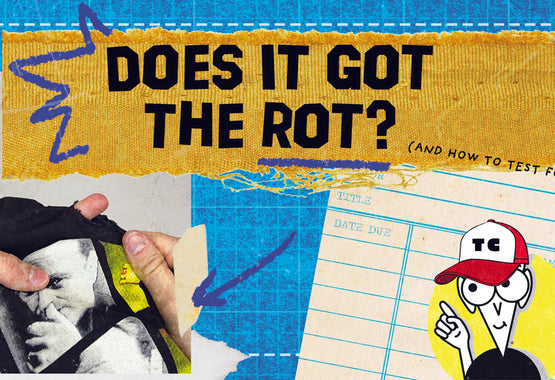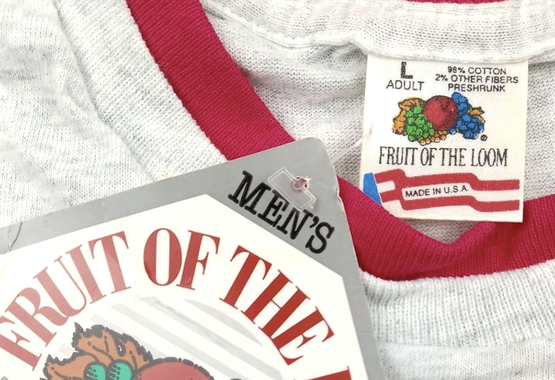What Dry Rot Is And Two Ways To Test For It In Your Tees
When I first encountered dry rot, I was shopping at a Goodwill Outlet waiting for another collection of blue bins to be rotated. Usually when this happens, I’m awkwardly pacing back and forth, glancing over leftover mountains of clothes to see if anyone missed anything during the initial frenzy. This time, it looked like someone did. An unmistakable sports logo with red tipped horns was peeking out from under an old set of faded sheets. The black tee had a large basketball graphic and the words “World Champions” printed across the chest. It was a Chicago Bulls championship souvenir from the 1990s that someone, somehow hadn’t scooped up yet. Awesome.
Until it wasn’t. As soon as I gave it a small tug the entirety of it turned to irritating ash. That chalky, itchy, acidic dust that anyone who’s been thrifting for any length of time recognizes immediately. It’s called dry rot, and it’s one of the most disappointing things to encounter when you’re looking for clothes on the secondary market.
What exactly it is wasn’t really known outside of a few corporate science nerds until recently. In October of 2022, Defunkd.com finally put in the legwork and asked around before posting about it. A writer on the site, known as Wax and Threads, hunted for the mystery behind dry rot by simply cold calling people in the know.
“After a number of phone calls and dead-end referrals,” they write, “we finally made a connection with someone from the Cotton Inc headquarters (you know, ‘The fabric of our lives’ people?)”
In short, throughout the '90s and into the early 2000s, sulfur-based dyes (particularly black) were used as a cheap alternative to fiber reactive ones. If a t-shirt isn't washed after production using these dyes, the fabric becomes acidic and withers away like the Wicked Witch of the West at the office water cooler. After years of sitting around as deadstock, the tee simply turns into a fragile mess of dust and blah.
Early detection is by far the best defense against further deterioration. Once found, a dry rotted shirt not too far gone can be washed and neutralized. The problem is, anything with rot is going to be decades old and untouched — likely hung in the back of someone’s closet forgotten about the entire time. Really, there are only two ways to know for certain if a shirt was colored using a sulfur-based dye. And in both cases, damage is likely already done.
Test #1
The first test is the easiest, but not always 100 percent. If a shirt has been sitting around for a long time, unwashed and transformed enough through the deterioration process it’s going to be extremely frail. Simply try to tear it, and if it rips like a wet tortilla, chances are it’s gone.
(Pro tip though: collectors will still buy these shirts if they’re a higher end collectible. Don’t try and rip it anywhere that’s noticeable. Try to do it on the bottom hem’s backside. That way, if it is damaged you can keep it to a minimum.)
Test #2
Because the problem is the prevalence of acid, you can use a pH meter and get an accurate reading of how far gone the t-shirt is.
“We know that shirts don’t start to rip until they have reached a pH balance in the 4s,” says Wax and Threads. “The lower the pH number, the more acidic (water has a pH balance of 7). By letting part of a deadstock shirt soak in water, we can actually test the acidity of the water and know if a shirt is vulnerable to dry rot and how close it is.”
Unfortunately, there is no known cure for dry rot outside of early detection. And with how destructive acid is on older goods and collectibles, there likely won’t ever be one. One of the biggest hurdles archivists and collectors face is the fact that, when things were made decades ago, not much thought was put into preservation. No one really knew that several decades later a Chicago Bulls shirt bought from K-Mart would be so sought after. Companies then thought about the cheapest and fastest way to get souvenirs on the shelves. Not that someone would want to wear it as vintage fashion far into the future.
That’s not to say that a t-shirt with dry rot is completely useless. As stated before, plenty of collectors will still purchase the rare, higher end tees and put them to artistic use. Textile professionals know safe ways to wash the current damage out to prevent further from happening. I’ve even seen people frame them using acid-free archival mounting techniques to turn them into viable wall art.
If nothing else, that vintage tee taught me a lesson to move on and hope for the next. Even if we wanted to, not everything from the past should or can be saved for current use. The world, after all, is cyclical. When one tee rips, more is sure to follow.













